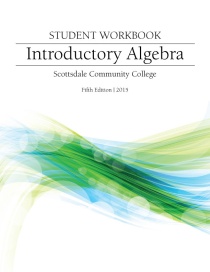
Introductory Algebra Workbook

This workbook was created through the efforts of instructors at Scottsdale Community College in Scottsdale, Arizona, has been used by thousands of students, and is continually improved. This workbook contains have lessons that were carefully and thoughtfully crafted to lead students on a path to understanding numbers and arithmetic.
Each lesson is broken into four parts, which an instructor can use some or all of:
- A Minilesson, in a workbook format, which can either be worked through in-class via lecture or groupwork, or through video lessons available on the Scottsdale Math blog or inside MyOpenMath.
- Practice problems
- A short assessment
- Online homework in MyOpenMath
The printed version of the workbook is available in looseleaf from the printing company listed to above; contact them for pricing and ordering information
License: Creative Commons Attribution Sharealike. This license is considered to be some to be the most open license. It allows reuse, remixing, and distribution (including commercial), but requires any remixes use the same license as the original. This limits where the content can be remixed into, but on the other hand ensures that no-one can remix the content then put the remix under a more restrictive license.
Formats:
- DOC. A DOC file can be opened using Microsoft Word or OpenOffice.org. It is an editable format
- PDF. A Portable Document Format (PDF) file is can be opened using the free Acrobat Reader. It is not an editable format.
Openness Rating (0-4): 3
Openness Comments: Word files are available from the authors on request.
- Unit R: Arithmetic Review
- R.1: Order of Operations Section
- R.2: Fractions Section
- R.3: Operations on Fractions Section
- R.4: Signed Numbers
- Unit 1: Introduction to Variables
- 1.1: Writing Algebraic Expressions
- 1.2: The Story of “x”
- 1.3: Evaluating Algebraic Expressions
- 1.4: Applications
- 1.5: Geometric Formulas
- Unit 2: Algebraic Expressions
- 2.1 Some Vocabulary
- 2.2 Like Terms
- 2.3 Distributive Property
- 2.4 Simplifying Algebraic Expressions
- 2.5: Applications
- Unit 3:Solving Equations
- 3.1 Algebraic Equations
- 3.2 Solving One-Step Equations
- 3.3 Solving Two-Step Equations
- 3.4 Solving Multi-Step Equations
- 3.5 Solving Equations – Applications
- 3.6 Writing Equations – Applications
- Unit 4: Inequalities
- 4.1 Inequalities
- 4.2 Solving Linear Inequalities
- 4.3 Solving Inequalities – Applications
- 4.4 Compound Inequalities
- 4.5 Absolute Value Equations and Inequalities
- Unit 5: Graphs
- 5.1 The Cartesian Plane,
- 5.2: Working with Scale in the Cartesian Plane
- 5.3: Characteristics of Graphs
- 5.4: Interpreting Graphs
- 5.5: Constructing a Graph from Data
- Unit 6: Formulas and Patterns
- 6.1: Connect the Dots?
- 6.2 Linear Equations – Two Variables
- 6.3: Graphing Equations by Plotting Points,
- 6.4 Intercepts
- 6.5 Horizontal and Vertical Lines
- 6.6: Looking for Patterns
- Unit 7: Introduction to Functions
- 7.1 Relations and Functions
- 7.2 Function Notation
- 7.3 Domain and Range
- 7.4 Practical Domain and Range
- 7.5: Applications
- Unit 8: Formulas and Functions
- 8.1: Words and Formulas
- 8.2 Formulas in Function Notation
- 8.3: Formulas in Function Notation – Applications
- 8.4: Graphing Functions
- 8.5: Connecting Representations
- 8.6: Applications
- Unit 9: Introduction to Linear Functions
- 9.1 Linear Functions
- 9.2 Graphing Linear Functions
- 9.3 Interpreting the Slope of a Linear Function
- 9.4: Using Rates of Change to Build Tables and Graphs
- 9.5: Is the Function Linear?
- Unit 10: The Equation of a Linear Functions
- 10.1 The Equation of a Linear Function
- 10.2 Writing the Equation of a Line in Slope-Intercept Form
- 10.3 Parallel and Perpendicular Lines
- 10.4 Applications – Slope-Intercept Form
- 10.5: Interpreting a Linear Function in Slope-Intercept Form
- Unit 11: Linear Equations and Inequalities
- 11.1 General Form
- 11.2 Applications – General Form
- 11.3 Linear Inequalities in Two Variables
- 11.4 Graphing Linear Inequalities in Two Variables
- Unit 12: Systems of Equations
- 12.1 Systems of Linear Equations
- 12.2 The Substitution Method
- 12.3 The Addition (Elimination) Method
- 12.4 Applications
- Unit 13: Polynomials and Exponents
- 13.1 Polynomials
- 13.2 Operations on Polynomials
- 13.3 Properties of Exponents
- 13.4 Multiplication of Polynomials
- 13.5 Applications from Geometry
- 13.6 Division Properties of Exponents
Supplements:
- MyOpenMath / Lumen OHM online homework. MyOpenMath is a free online homework system, built on the open source IMathAS assessment platform.
It provides randomized, algorithmically generated homework with automated grading of numerical and algebraic answers, similar to WebAssign and MyMathLab.
It also provides a course management system with gradebook, file posting, discussion forums, etc.
Assessment sets have been created for this textbook, which may be available for self-study by students, or can copied as a starter course shell by faculty.
MyOpenMath use is free with community support through forums. For Washington State faculty, the WAMAP.org site also mirrors this content.
Lumen OHM is a commercial alternative to MyOpenMath that provides support for faculty and large scale adoption and administration, service level agreements, and additional curated course bundles. - Videos. See the comments below for details.
- CourseWare package. Courseware packages typically include a course structure with syllabus, some form of homework assignments, and some type of assessments. They may also include: videos, lecture notes, handouts, worksheets, quizzes, etc. See comments below for details
Notes: This is a comprehensively design course packet, intended to be customizable for use in face-to-face, hybrid, and online courses.